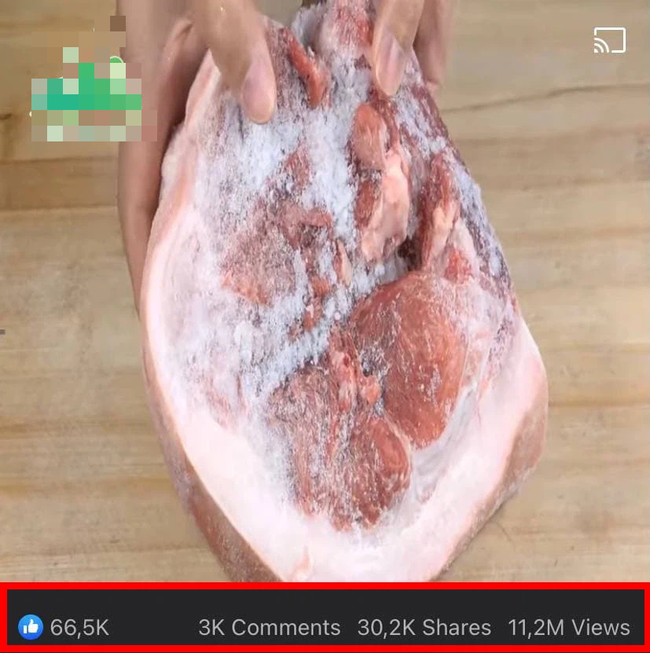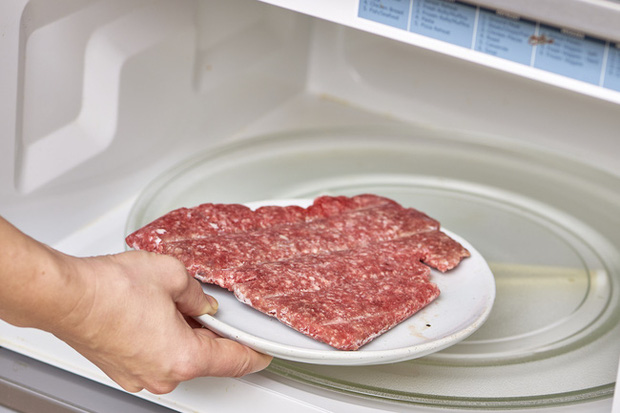Freezing meat is a common practice for most of us, especially during social distancing periods like the present. Unable to go to the market or grocery store daily, buying a few kilograms of meat at once is understandable.
And defrosting the meat correctly is still a contentious issue, as well as a concern for many women.
The online community criticized a video tutorial on defrosting meat just because of a very basic mistake
Not long ago, a Facebook Fanpage shared a video on how to defrost pork after freezing. The video attracted over 11 million views and over 30 thousand shares but was heavily criticized by the online community.

Looking at the interaction is shocking!
In order to demonstrate the process of defrosting pork, this Fanpage used a large piece of meat (as shown in the image). The piece of meat was soaked in water with 1-2 teaspoons of salt and white vinegar for about 15 minutes, then sliced into small pieces.

According to this video’s instructions, soaking the large piece of meat with water, salt, and vinegar will help the meat become tender quickly
After soaking, the meat is sliced into small pieces and then soaked again with water?!

Something seems fishy here…
And the mistake that most viewers feel makes this method unscientific is: Do not freeze such a large piece of meat, defrosting and freezing it again will make the meat lose its quality. Moreover, no one washes meat after slicing, which further degrades the meat’s quality!

The comment is harsh but correct!

And there’s even a spelling mistake… “ĐÔNG” should be correct!
Proper thawing methods that do not compromise the quality of the meat
Before freezing meat, you need to wash the meat, drain it, and then cut the meat into small portions for one meal. Put the cut pieces of meat in a ziplock bag/box and place it in the freezer.
Absolutely do not freeze such a large piece of meat, defrost part of it, then freeze the remaining part. In this way, the meat loses its quality and becomes less tasty after cooking.
Absolutely do not defrost meat at room temperature. Nutrition experts say: Never defrost meat at room temperature for more than two hours. As soon as the ice layer melts, the temperature of the food will change and create conditions for bacteria to quickly infiltrate. Harmful bacteria such as staphylococcus, salmonella, E. coli, and campylobacter can grow rapidly at temperatures ranging from 4-60 degrees Celsius.
In fact, the number of bacteria can double after just 20 minutes when the temperature falls into this “dangerous” range.
1. Thaw in the refrigerator
Thawing slowly in the refrigerator is one of the safest and most effective methods. Large-sized food items may take 1-2 days to thaw in the refrigerator, while smaller pieces of meat only need overnight.

Place the frozen piece of meat in the refrigerator to thaw (illustrative image)
Note: If you thaw meat in this way, you should put the meat in the bottom drawer of the refrigerator because it may drip and affect other food items. This also helps to avoid food poisoning and foodborne diseases.
2. Use a microwave
Using a microwave to defrost meat is the fastest and most convenient option. However, this method is only truly effective for small pieces of meat.
If your microwave has a defrost function and a temperature adjustment function that is suitable for cooking each dish, use it. If not, you need to set the microwave to operate at low power and gradually increase the time until the meat is fully thawed.

Use a microwave for quick defrosting (illustrative image)
3. Soak the meat bag in cold water
Absolutely do not use hot/warm water to defrost meat. Defrosting meat with hot water can create conditions for bacteria to attack and accumulate toxins, while using cold water (water from a normal tap) is very safe.
Put the piece of meat in a ziplock bag and place it in a sink filled with water. You can place the meat bag under running water or change the water every 30 minutes. The advantage of this method is that placing the frozen piece of meat in the water will shorten the thawing time compared to thawing in the refrigerator.
Although the time depends on the amount of meat, the process of thawing meat in water can save a significant amount of time compared to the method of using the refrigerator.

Soak meat in cold water to defrost (illustrative image)






































![[How To] – 10+ irresistible homemade hotpot recipes](https://meo.tips/wp-content/uploads/2023/12/goi-y-4-mo-100x70.jpg)

